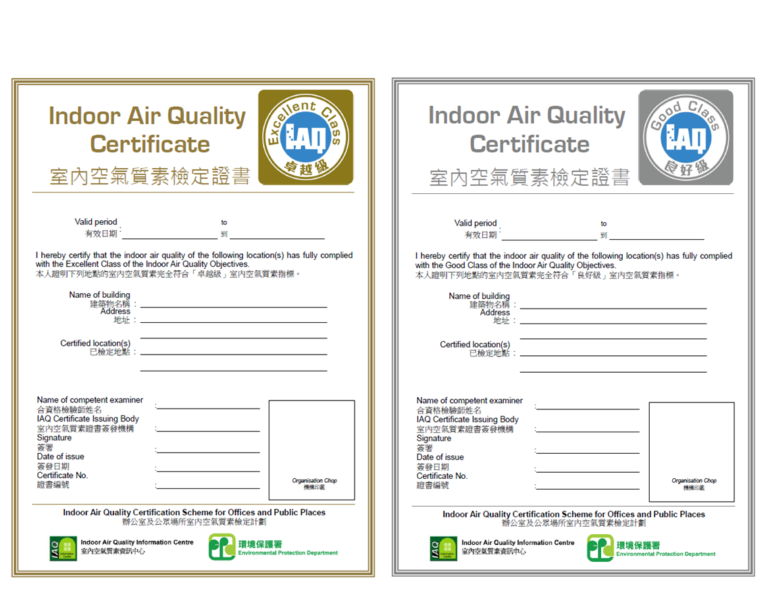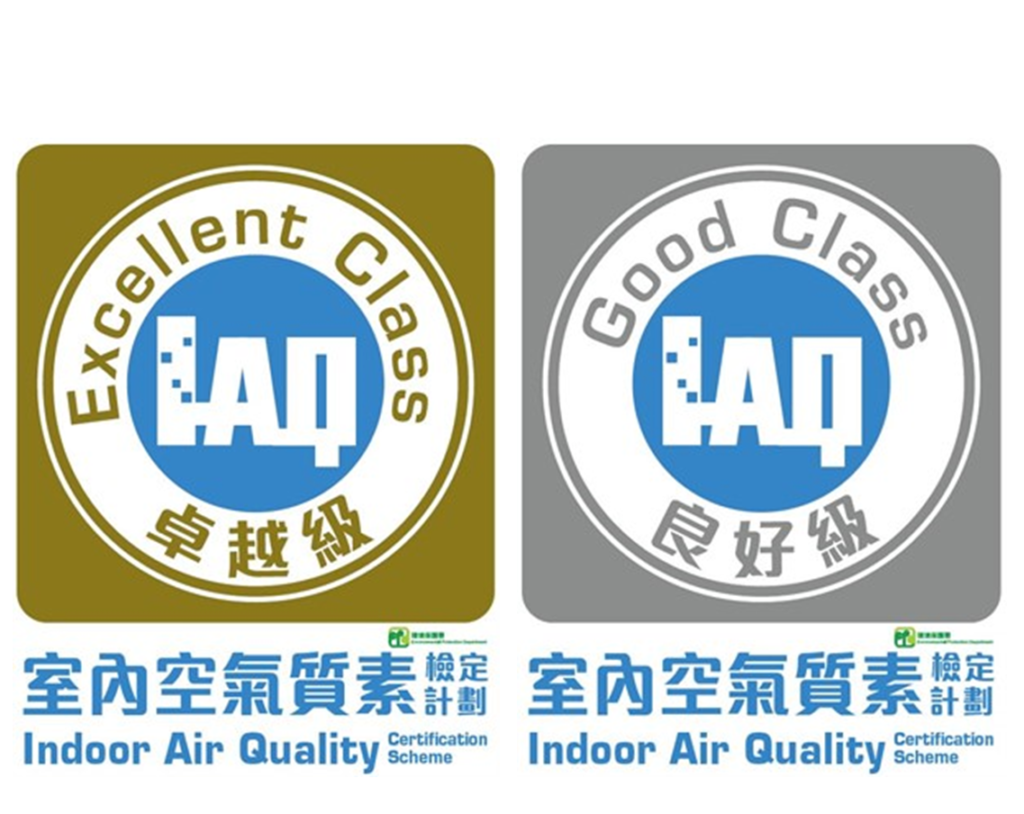Home > IAQ Certification Scheme > Background
Background
To improve the IAQ and promote public awareness of the importance of IAQ, the Government implemented an IAQ Management Programme in 2000. One of the core tasks of the Programme is to launch a voluntary IAQ Certification Scheme for Offices and Public Places (the “IAQ Certification Scheme”) in 2003.
The IAQ Certification Scheme aims to:
- recognise good IAQ management practices; and
- provide incentives for owners of premises/buildings or property management companies to pursue the best level of IAQ.
Key features of the IAQ Certification Scheme
Key features of the IAQ Certification Scheme are –
- a 2-level IAQ objectives (Excellent Class and Good Class) is used as the benchmark to assess IAQ of premises/buildings;
- a voluntary and self-regulatory approach is adopted for annual certification;
- participation is free but premises/building owners or management are responsible for all expenses, including but not limited to, employing accredited IAQ Certificate Issuing Bodies (CIB) to assess IAQ of their premises/buildings against the IAQ objectives;
- CIB will issue an IAQ certificate for premises/building owners or management to register with the IAQ Information Centre if the IAQ objectives are complied with. The certificate and IAQ labels provided by the IAQ Information Centre should be put up at a prominent location for the public information;
- IAQ Information Centre will issue electronic IAQ logo (“e-Logo”) to premises/building owners upon request. The use of the electronic IAQ logo should follow the prescribed guidelines;
- the certificate is valid for 12 months. For certificate renewal, a full set of parameters on IAQ objectives shall be measured/assessed once every 5 years, and for the 4 years in between, only selected parameters need to be measured/assessed annually if certain conditions are met;
- certification is generally made on the basis of a building as a unit. Nevertheless, premises/building owners or management can choose to certify certain parts or certain floors of a building; and
- premises/building owners or management have to manage post-certification IAQ to ensure IAQ is maintained at the certified level.
Since the launch of the IAQ Certification Scheme in 2003, the World Health Organization (WHO) has published two IAQ guidelines in 2009 and 2010 respectively on dampness and mould, and selected pollutants (viz. formaldehyde (HCHO), radon, carbon monoxide (CO), nitrogen dioxide (NO2), benzene, naphthalene, polycyclic aromatic hydrocarbons (PAHs), trichloroethylene and tetrachloroethylene). Taking into account local circumstances and the practicability of adopting the latest WHO’s IAQ guidelines, the IAQ objectives of the IAQ Certification Scheme adopted since 2003 (“Old IAQ Objectives”) have been revised for implementation starting from 1 July 2019.
IAQ Objectives
In light of tIn light of the IAQ guidelines published by the World Health Organization in 2009 and 2010 respectively on dampness and mould, and selected pollutants (viz. HCHO, radon, CO, NO2, benzene, naphthalene, polycyclic aromatic hydrocarbons (PAHs), trichloroethylene and tetrachloroethylene), EPD completed a review of the prevailing IAQ objectives adopted since 2003 under the IAQ Certification Scheme for Offices and Public Places (the Scheme) to update the IAQ objectives. The latest IAQ objectives is updated in July 2019 Summary of the IAQ objectives can be downloaded from here.
To distinguish premises complying with the latest IAQ Objectives, a set of IAQ certificates and IAQ labels is issued for certified premises complying with the IAQ Objectives since July 2019.
In addition, the IAQ Information Centre will issue electronic IAQ logo (“e-Logo”) to IAQ certificate holders upon request for promotion of their efforts in maintaining good IAQ and for raising public’s awareness of IAQ. The use of the e-Logo should follow the prescribed guidelines.
IAQ certificates

IAQ labels

Why participate?
Good IAQ in offices and public places could –
- safeguard the health of building users
- increase productivity of the workers
- attract more tenants or customers
By participating in the IAQ Certification Scheme, your efforts in achieving good IAQ will be publicly recognised. It will also help develop a partnership amongst all stakeholders in the premises in maintaining a pleasant indoor environment.

Applicability
In general, buildings or enclosed areas for the use as offices or public places which are served by mechanical ventilation and air conditioning (MVAC) system may join the IAQ Certification Scheme. MVAC system means the equipment, distribution network and terminal that provide, either collectively or individually, the processes of heating, cooling, humidification, dehumidification, ventilation or air-purification or any other associated processes to a conditioned space. It does not cover window-type air conditioners or split-type air conditioners. Public places is defined as “any theatre, place of public entertainment of any kind, or other place of general resort, admission to which is obtained by payment or to which the public have or are permitted to have access”. Examples of eligible buildings are office buildings, shopping malls, hotels, restaurants, theatres, cinemas and funeral parlours, etc.
The certification is generally made on the basis of a building as a unit. Nevertheless, premises/building owners or management can choose to certify certain parts or certain floors of a building. Where a shopping mall or scheduled premises* listed under Schedule 2 of the Public Health and Municipal Services Ordinance (Cap. 132) forms part of the building, it is required to be certified separately. The location of the certified premises/buildings must be clearly stated in the application form and the certificate.
* As at July 2018, the scheduled premises listed are restaurants, dancing establishment, theatres, cinemas, funeral parlours and factory canteens.
Fees
Participation in the scheme is free of charge.
However, owners/management of premises/buildings are responsible for all expenses associated with participating in the scheme (e.g. cost for employing the CIB for certification and undertaking remedial actions, etc.).

 Back
Back